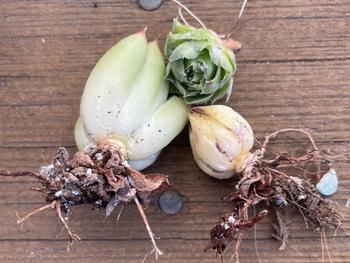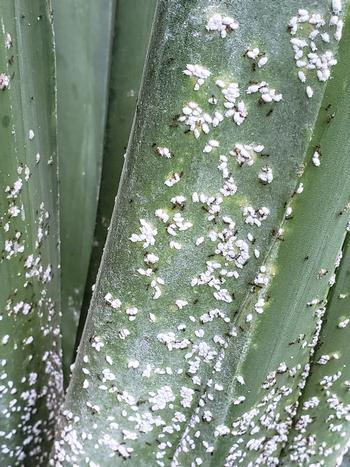Fall 2023
Houseplants looking sick? It might be mealybugs.

Mealybugs are very small, oval, whitish insects that cover houseplants with a cottony, powdery, or waxy material, often along the veins of leaves or where leafstalks join stems. More than 170 species of mealybugs exist in California. Depending on the species and the environment, they may produce two to six generations of 100 to 200 or more eggs per year. A few mealybug species feed on roots.
Which plants are susceptible?
Mealybugs are common pests of orchids, palms, dracaena, philodendron, and succulents, among others. Plants growing indoors or in greenhouses are especially vulnerable because year-round mild temperatures favor mealybug populations, and indoor plants are usually not exposed to the natural enemies that often keep mealybugs under control outdoors. Mealybugs are often introduced on new houseplants or on tools or pots. For that reason, it is important to inspect any new plants thoroughly before adding them to your houseplant collection.
What are the signs of an infestation?
The most common signs that mealybugs have moved in are stunted plant growth, leaf wilting, and/or yellowing. High populations feeding on foliage or stems can slow plant growth and cause leaf drop; however, healthy plants can tolerate low populations without significant damage. Look closely for clusters of tiny wooly white nests in tight crevices on the plant, such as behind or inside leaf bases, in branch crotches, within leaflet folds, or in flower clusters. Also inspect any plant stakes and clips as well as pots where colonies may be hiding.

If you find mealybugs in your houseplants, scrape or wash them off with a spray of water, dispose of infested plant parts, and consider judicious use of horticultural oil or insecticidal soap labeled for use on your plant species.
Small infestations can sometimes be controlled with 70 percent (or less concentrated) isopropyl (rubbing) alcohol applied directly on the mealybugs with a cotton swab. Test the solution on a small part of the plant one to two days prior to make sure it does not damage the plant. In some cases, a much more diluted solution may be advisable. Where infestations are extensive, a 10 to 25 percent solution of isopropyl alcohol can be applied with a spray bottle. Be diligent: plan to repeat this procedure every week until the infestation is gone. If the infestation is heavy or does not respond to treatments, the best solution may be to dispose of the plant before more plants become infested.
Avoid unnecessary applications of nitrogen fertilizer on plants with mealybugs. High rates of nitrogen coupled with regular irrigation may stimulate tender new plant growth as well as mealybug egg production.
If you continue to be plagued with these bugs, consider using only plant species that are not prone to mealybugs for at least a year or two to reduce mealybug presence in your home.
